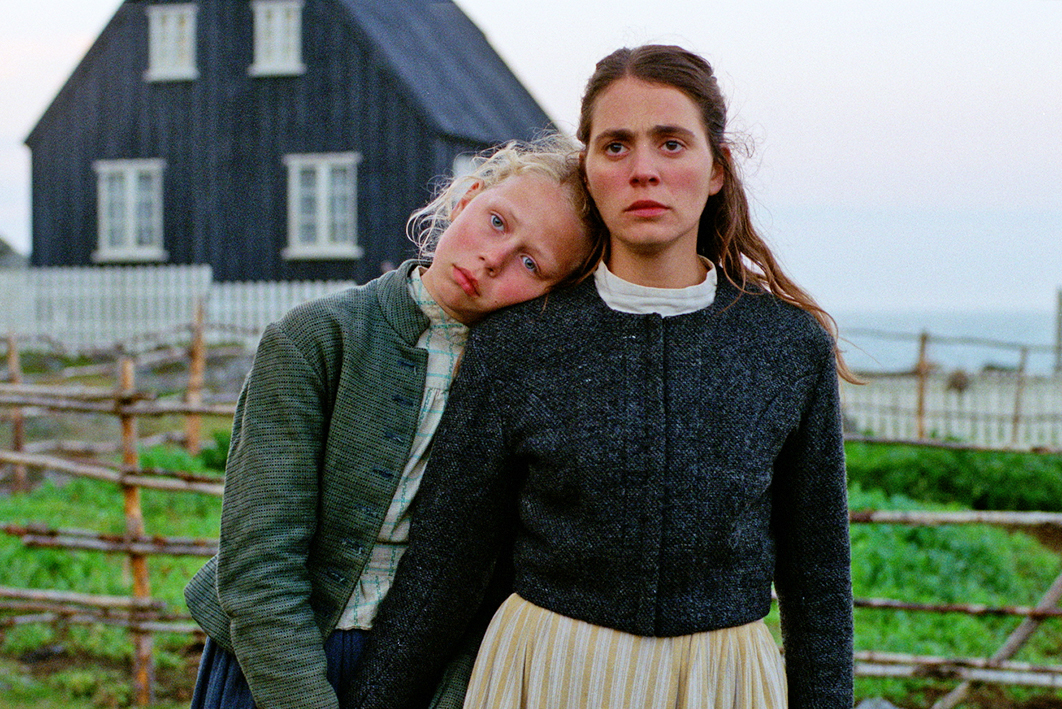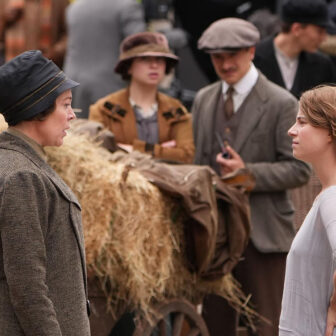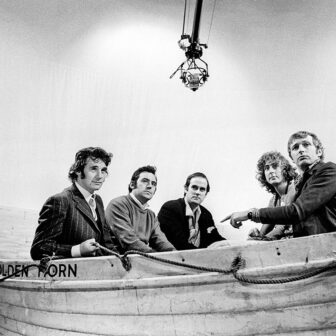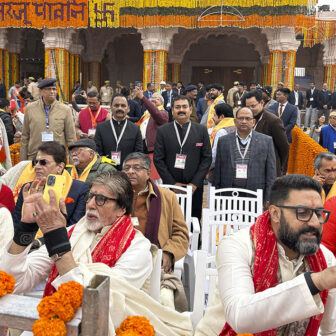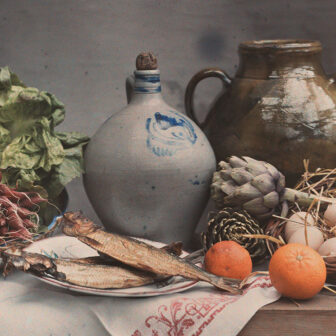Godland, the third full-length feature from Icelandic director Hlynur Pálmason, is a study in the frailty of faith and of human connectedness. It is also a masterpiece. Telling its powerful human story by means of a stunningly successful integration of moving and still photography, the film explores the complex role the camera plays in our lives, both facilitating and undermining our connections with others.
As the film opens, a young priest walks urgently across the frame. He is heading towards a meeting with his superior, where he is to receive final advice before embarking on a journey. It is the end of the nineteenth century and Lucas (Elliott Crosset Hove) is being despatched from Denmark on a mission. He is to travel by sea and then by arduous overland trek to a remote settlement on the southeast coast of Iceland, where his task is to oversee the building of a church and lead the congregation in worship. He will be travelling to another country and, crucially, to another language.
Lucas’s gait, bent forward in his haste, suggests his determination to leave no room for doubt or hesitation. He is indeed on a mission. His pace suggests too the importance of getting started, for as his superior, Vincent, makes pragmatically clear in this farewell briefing — delivered in tones both avuncular and forbidding — the church must be completed by the winter. There must be no delay.
The briefing over, Lucas is shown fussily setting up a cumbersome wet-plate camera in preparation for taking a photograph of Vincent, an image intended to serve as a memento and a marker of the occasion. Vincent might be the subject of the photograph, but it is the photographer who is more clearly revealed, as both a traditionalist and a modern man. Lucas is a servant of God and a keen amateur photographer, in thrall to the new technology. We can already see that the two don’t sit easily together.
Vincent is played, in a small but resonant part, by the distinguished Danish actor Waage Sandø, who incidentally gives a masterclass in talking while shelling and eating a boiled egg (a scene that rivals Robert De Niro’s famous boiled egg scene in Alan Parker’s 1987 film Angel Heart, to which it surely alludes). He poses authoritatively in front of a patterned backcloth, his formal neck ruff appearing to separate his head from his body, in the manner of a portrait. In a series of subtle gestures, he adjusts his clothing and his expression as he waits to adopt those necessary seconds of stillness when his image will be captured. There is an atmosphere of theatrical significance. It is indeed an occasion, a moment of enforced calm before the urgent departure.
As we gradually learn throughout the course of the film — including in one brilliantly underplayed and comic scene at its midpoint — Lucas’s commitment to the urgency of his mission is compromised by his propensity for delay and deferral. His bulky camera and equipment also serve as an impediment, a literal burden (a publicity still shows Lucas, about to collapse under the weight of the camera on his back, arriving on the Icelandic shore) that weighs on him and slows him down.
Lucas displays a combination of confidence and uncertainty, of urgency and willed delay, that grows ever more starkly contradictory. It is a theme that permeates the entire film, embodied in the complex series of steps involved in wet-plate photography, which requires the right combination of perfect stillness, as the image is taken, and controlled urgency, as it is developed.
Starting out on his journey across the formidable Icelandic landscape, Lucas struggles to control his horse. The guide, Ragnar (Ingvar Sigurðsson), impatiently demonstrates how he must handle the reins more confidently, judging when to apply force and when to let up, to show the horse who is in charge and to control its pace. “Pull a little, then release,” Lucas is advised later on, but he never quite learns a comfortable balance, whether in making a photograph or riding a horse. In everything he does, the strain shows.
We are told during the opening credits that a mere seven of Lucas’s photographs have survived, from which, it is implied, the story of his journey and eventual fate have been constructed and imagined. It is one of many instances in which Pálmason subtly explores the role of photography in helping us to understand ourselves and our place in the world. Just as Godland brings those supposedly historical images to life, so the extraordinary cinematography of Maria von Hausswolff, Pálmason’s frequent collaborator, repeatedly alludes to still photography.
Von Hausswolff’s camera shows characters frozen (sometimes almost literally) in moments of inaction or contemplation. A shot of the Icelandic landscape will appear as if all is unmoving, until a horse or a bird or a small human figure wanders into the frame to remind us that what we are looking at is indeed a moving image rather than a photograph. This intermingling of the two genres, photography and cinema, is characteristic of Pálmason’s and von Hausswolff’s work. A White, White Day (2019), for example, begins with an extended series of near-still shots of a stark and isolated building as it appears in different weathers.
These allusions to photography are reinforced by Pálmason’s habit of centring the subject — a building or a person or a natural object — in the manner of traditional portraiture. We are constantly being invited to pay attention, to look closely at what is before us. This effect is further reinforced, as many commentators have pointed out, by Godland’s 4:3 aspect ratio, with rounded corners, which seems to echo the proportions and appearance of Lucas’s wet-plate photographs.
The decision to deploy that historical cinematic ratio to capture the look of nineteenth-century photographs is immediately convincing, but when it comes to similarly capturing the imposing dimensions of the Icelandic landscape, and forcefully conveying the relative smallness of the people within it, it seems counterintuitive, a rather odd directorial decision.
Yet both the director and cinematographer felt, as von Hausswolff has commented, that “framing Godland in 4:3 aspect ratio on 35mm film created a real connection to the landscape,” as well as to “the portraiture of the people.” That “real connection” is very effectively established by implication as well as directly through the camera. The audience is encouraged to imagine what lies beyond the frame as well as what is within it.
Because the screen’s borders don’t suddenly expand to modern dimensions to take in the landscape, as they might have done, we both see and imagine its vastness through the confines of the more traditional 4:3 framing. The frame seems to say that the vastness and disorienting visual experience of the Icelandic landscape — an experience W.H. Auden likened in Letters from Iceland (1936) to “walking the wrong way on a moving staircase” — cannot be fully captured by the camera.
As if to emphasise this point, Pálmason further plays with frames and framing throughout the film, experimenting with different ways of capturing what cannot be fully contained. We see the landscape through the lens of Lucas’s camera, through the triangle of open tent flaps, through windows and doorways, in near darkness and in the obscurity of fog. We are constantly reminded of how difficult it is to see it all at once.
The vulnerability of humans within this landscape is shown in painterly long shots. Lucas and his party cross the frame on horseback, their slow, deliberate pace ironically echoing the opening scene in which the eager, nervous priest bursts across the screen. Later, nature’s dominance is demonstrated in one slow, impressive 360-degree pan across the landscape, as the focus ever tightens until it lands upon the supine figure of Lucas, lying still, with his eyes closed. Were it not for the sound of his breathing, he could be dead. He could almost be posing.
Stay perfectly still, the ship’s crew are instructed as they assemble for a group photograph earlier in the film, their faces overlaid with white to ensure more effective contrast in the final image. Keep still, they are told again, “as if you’re dead.” We learn almost nothing about this ship’s crew. Similarly, the men and one woman who accompany Lucas on his overland journey, apart from the leading guide, Ragnar, remain virtually unknown, as do the members of the small coastal community when the party arrives at its destination.
We know these subsidiary characters almost exclusively by their faces, and by the attention the camera pays to them, not only in Lucas’s photographs but also in the lingering, portrait-like focus of the cinematography. Almost entirely by visual means, we get a strong impression of their individuality — they are not just figures in a landscape.
The individual and group portraits that Lucas makes — of his priestly mentor, of the crew of the ship taking him to Iceland, of his unnamed translator, of the young woman he seems destined to marry, and of her father — all seem to offer their subjects proof of their existence within an unforgiving world. Meanwhile Lucas, who might nowadays be described as short on social skills, approaches his most meaningful, if fleeting, connections mediated by the camera.
In the film’s most striking instance of this kind of mediated intimacy, Lucas and his unnamed translator (Hilmar Guðjónsson) are seen striding into the landscape, camera and equipment on their backs, to “take a picture.” Lucas photographs the translator posed against the landscape, and this seems to lead directly to a greater understanding and connection between the two men. We next see them standing, bare-chested and apart from each other, facing the spray of a waterfall. They jointly raise their arms, if not in worship of nature, then in something close to it.
In another instance of the power of nature, the party of travellers comes to a swollen river that must be crossed if they are to continue their journey. Rivers are “difficult to read,” Vincent has warned Lucas earlier, and Ragnar, the Icelander who knows the country as no other, advises strategic withdrawal. They will try again in a few days, when the waters will have subsided. But Lucas insists on proceeding, putting himself and his companions in danger. At the crucial moment, rather than pausing — easing up on the reins — he plunges forward.
Lucas comes close to death during the gruelling journey. “I want to go home,” he cries in despair. But he then undergoes a kind of resurrection, brought back to life first by the dour Ragnar and then by a Danish widower, Carl (Jacob Lohmann) and his two daughters — Anna (Vic Carmen Sonne), born in Denmark, and Ida (Ída Mekkin Hlynsdóttir), born in Iceland — who house and care for him. Lucas, in return, makes a portrait of each of them.
In preparing to photograph Anna, Lucas gently gently smears white powder on her face to make her ready for the camera, later calling her over excitedly to the makeshift developing tent to witness the emerging image. I look old, says Anna as her face starts to appear in the developing tray (a reaction that subjects often had to their wet-plate portraits when the complex pattern of contrast had not quite worked to their advantage). Young and beautiful, responds Lucas, uncertain whether to look at Anna or at the image he has just made.
Photography, which tantalises with its apparent promise of facilitating his connection with others, ultimately fails Lucas. In a cruelly dramatic scene towards the end of the film, Ragnar, the man who has guided him across Iceland to his destination and has saved his life along the way, asks Lucas to take his photograph. He wants to own an image of himself. Lucas refuses, rejecting any possible connection. For him, Ragnar is an animal, a “swine.” Much more than language separates them.
Ragnar has earlier had the opportunity to be in a group photograph. But he has moved at the crucial moment, spoiling the image — your dog moved less than you, Lucas mutters angrily — and Lucas destroys the plate in frustration. The failure of the photograph embodies the failure of the relationship — with Ragnar, with Iceland. In a film replete with foreshadowings and visual parallels, it foreshadows the tragedy at the end.
Of all Lucas’s human subjects, Ida, the younger, more carefree daughter, is the only one to adopt the characteristic photographic postures of our time — rather than formal and submissive, obedient to the camera and to the photographer, she is ironic, self-aware, cheeky. She is not at all intimidated. Others sit perfectly still, as instructed, looking “straight into the eye.” Posing with her horse, she stands on its back, then seats herself the wrong way round, then turns her face away from the camera. Lucas allows himself the beginnings of a smile at this performance, while Ida’s horse ambles away with her, out of the frame.
Surrounded by failure and thwarted ambition (“we are all very small and fleeting,” says her father to Lucas), Ida is nevertheless optimistic. She is the only character to be entirely comfortable in both Icelandic and Danish. The rest speak only one language, or speak the other one imperfectly, or are reluctant to speak it at all. Even the unnamed translator sometimes struggles to understand what Lucas is getting at. But Ida slips easily between the two languages, confidently demonstrating, by passing her hand across her face in the manner of a slow camera sweep, how she can move smoothly from one to the other. In a film rather short on optimism, it is a small sign of hope and of faith in the future. •
